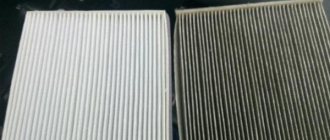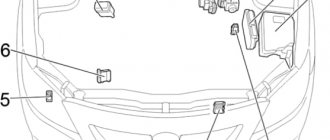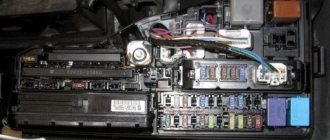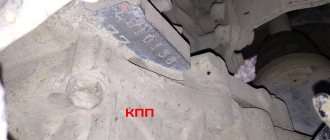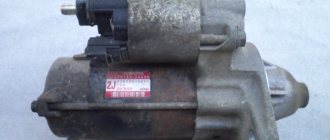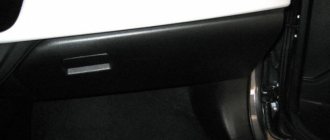Despite the fact that the vast majority of modern cars continue to run on combustible fuel, without electricity the cars would still not be able to move. Electricity is needed primarily to start the engine. And after that, various devices must constantly work. In a vehicle, to start the engine, the current source is the battery, and as soon as the power unit is running, the generator comes into play. It is he who generates electricity to illuminate the instruments on the panel, buttons, interior lighting and the operation of the car’s lighting elements. But when electrical outages or short circuits occur, why don’t the devices burn out? For these purposes, there are fuses that are, in fact, in the center of the electrical circuit. They are the ones who take the blow and prevent sensors and other units from breaking. There is a fuse box in every car, including the Toyota Highlander. They are easy to change, however, many do not know where exactly this block is located.
And here you will find out what batteries are installed on the Highlander.
What is a car electrical circuit fuse
It is with fuses, which are also called fuses or fuses, that, as a rule, malfunctions of all electrical appliances in the car are associated. If something that depends on electric current does not work, then you first need to check the integrity of the plates. There can be more than 100 of them in the car of different sizes, shapes, colors and current strength.
This type of circuit protection consists of a plastic housing containing a solid metal wire. The plastic casing looks like a flag with two metal teeth protruding from it. In old machines it is made in the form of a cylinder with external wire installation. It is with these teeth that the insert is attached to its seat, thereby completing the circuit.
Automotive fuses in car electrical circuits are used for the following purposes:
- circuit overload protection;
- protection against fire after a short circuit;
- protection of the integrity of electrical appliances in the event of wiring failure;
- control of electric current level;
- troubleshooting tool.
Electrical fuses are divided into 4 types. According to the type of metal used in them:
- tin;
- aluminum;
- lead;
- from an alloy of tin and lead.
The speed of response is important in their work. The faster the wire breaks, the better the device tied in the chain will be preserved. That is, the wiring will not overheat, elements will not burn out, and a fire will not break out. Therefore, the wire inside the flag is made from a material that has a relatively low melting point and transition from solid to liquid state.
Electrical fuses of different units have different sizes and are divided by type of device. For certain circuits the following notations are used:
- FJ10;
- FTX NORM;
- MAXI FX;
- FTX NORM.
All fuses, except FJ10, which are located only under the hood, are installed both in the cabin unit and under the hood.
To distinguish the flags depending on the current strength, they are painted in different colors. This helps you quickly navigate when replacing.
Knowledge about complete disassembly of a Highlander car can help: you can read about it here.
Highlander rear wiper repair
After the purchase (the seller warned me), the rear wiper did not work. The first time I turned it on, it advanced a little and died. First of all, I opened the glass and sprayed it with Vedashka. The janitor began to walk easier, but did not work. A few days later I decided to look at the mechanism and motor. I removed the panel from the door, there are 4 bolts for a 10mm key. Then there are 4 screws for a Phillips screwdriver and the whole mechanism is visible (in the photo). I looked, everything seemed to be fine. But for some reason it doesn't work. I took it apart, turned the motor with a screwdriver, and everything started moving. But then everything stopped again. After several repetitions, it began to run constantly. In general, I let the motor run for 5 minutes, after which it started to start normally. I put everything back together. It was not possible to disassemble the motor. Perhaps it was stuck because the wiper itself was moving slowly and the brushes were fried. Let's see what happens next.
Toyota Highlander 2012, petrol engine 3.5 liters, 273 hp. p., all-wheel drive, automatic transmission — breakdown
Cars for sale
Toyota Highlander, 2011
Toyota Highlander, 2012
Toyota Highlander, 2011
Toyota Highlander, 2012
Comments 9
Maybe. But at the beginning of the blog post it was written that it was sprayed with water and it didn’t work. I had exactly the same symptoms. You turn it on, it worked for about 3 seconds, the wiper advanced and stood up.
Also for me. He moved a little and stood up. It moved very hard in the glass. Apparently it was hard for the motor, the protection worked, and he got up. Well, then, apparently, it was already very hard that I couldn’t move it and the brushes got burnt.
The previous owner said that he did not use the wiper, apparently because of this it turned sour. The same thing happens with handbrake if you don't use it.
1) the place where it touches, if it is not installed along the teeth; 2) a body that simply moves to the bottom. Of course, it can be removed if you pull off the circle where the windshield wiper clamp is inserted; 3) this is the cover where the contact plug is inserted. It is held on by clamps. Easy to remove.
Good evening. I had the same thing until it burned out and the fuse didn't help. The motor got hot, the brushes on the rotor got hot, the housing where the brushes are inserted melted, eventually everything shorted out and the motor burned out.
True, I didn’t design the windshield wiper blade, but the motor would have had enough strength to turn the blade)))) If the motor was at least once removed and disassembled, plus the gears were removed, then perhaps the pitch could be lost, as a result the rod (let’s call it that) touches the wall of the housing. which transmits movement from the motor to the wiper blade and prevents it from rotating. At first, the motor itself will simply turn off (you can hear the clicks), but then it will lead to its combustion (or rather, the brush housings on the rotor). Adjustments are made by rearranging the teeth with the housing cover open. It’s done with two people, one at the motor and the other on. off motor.
The motor can be removed. There you unscrew three bolts. The plastic cover can be easily removed (or rather, pushed aside) to get to the third bolt. The top plastic cover where the plug with wires is inserted is removed, the microcircuit remains on the main body. You remove the motor housing (in the form of a barrel), and everything is visible, the rotor, the brushes, the housing where the brushes are inserted.
I ended up buying a new motor. Or rather, a complete mechanism.
The motor also burned out, that is, first the fuse on the motor burned out, the electrician made a thin jumper, since the motor fuse was soldered to the body of the motor itself, after several uses, a strong burning smell appeared, and the motor burned out completely, apparently did not take into account the fact that was described by you. Now the question is, was the mechanism itself expensive? Is it really not possible to find the motor itself separately? I looked everywhere and couldn’t find it, and the mechanism itself even used costs from 7 thousand! But I found a mechanism from the first one, it costs much less, the question arose whether a motor from it would be suitable?
Found it on Avito, while disassembling it. The man bought a second high for himself, and at the same time sold unnecessary spare parts. I bought it for 4500. I don’t know about high 1. Advice - find it through friends or even on the street there will be an option to see how everything works on high 1 (I sometimes do this)))). It may be suitable, but the modes will be different.
There a relay is responsible for the mode, like a worm mechanism, and the motor itself rotates as the current is given to it, or am I mistaken)
There is not a big diagram there in my opinion (I already forgot). When I took mine apart everything was perfect. Then he climbed into the motor, the plastic around the rotor and brushes melted. Everything else is perfect. Apparently the teeth were out of step and jammed (in the photo below I showed the place of the wedge). Disassembled and when two people are better to set up.
Why do fuses trip?
Most often, the protective plate of the cigarette lighter burns out. This is because various additional devices are constantly connected to it, such as a radar detector, lighting, and so on. In addition, a charging adapter for a mobile phone or a compressor plug for inflating wheels is periodically installed in the connector.
If the current strength of additional devices exceeds the maximum value of the electrical fuse, the latter begins to melt and the units stop working due to an open circuit.
ADDITIONALLY! Some car owners deliberately increase the maximum power limit in the cigarette lighter power supply. This cannot be done! The cross-section of the wiring installed at the factory is also calculated from the load that appears in the system. Therefore, the wires may not withstand and overheat, which will lead to a short circuit and possibly a fire.
Especially in winter, the protective elements of the washer often burn out. This happens due to the fact that the liquid in the washer reservoir and system pipes freezes. The pump “stresses” more, the current level increases, which leads to burnout. To avoid this, you should not fill with plain water at subzero temperatures or frosts at night.
Another element in which a short circuit often occurs is the windshield wipers. A breakdown will occur if you try for a long time to force frozen wipers to operate using the steering column switch. Therefore, in the morning it is necessary to check the windshield wipers for freezing and thaw them mechanically manually before starting the car. As a last resort, you should wait until warm air comes out of the heater nozzles and frees the rubber wipers from ice.
Heated windows and mirrors suffer from a break. Their wires, as a rule, are located in the doors in corrugated hoses. Over time, they can fray and cause a short circuit.
Lighting fuses will blow if you install non-standard bulbs with increased power. Therefore, as the current increases, the wires should also be strengthened. Otherwise, the same thing will happen as with the cigarette lighter.
rear wiper operation: question
When you turn the switch from the OFF to WASH position, liquid pours onto the glass and the wiper does not turn on. Judging by the electrical diagram, diode D16 is responsible for turning on the wiper in this mode: Rear Wiper and Washer It seems that the diode should be located somewhere under the instrument panel, but I couldn’t find it. Has anyone encountered this?
If I understand correctly, then everything is fine - as it should be. turn the switch down and hold it - liquid flows; when we release it, it returns to the off position on its own; one click up - the wiper works at low speed; another one is “fast move”; and finally we turn the switch up (the switch) all the way - liquid flows, the wiper operates in the “high speed” mode. when released, the switch returns to the “fast speed” mode.
I hope you will find the answer to your question in my essay =), and if not, then call me =)
- Login or register to post comments
On all previous cars (Volvo, Honda, VAZ), the wiper turned on itself in the washing mode. Judging by the diagram, it MUST turn on in the “switch down” mode. otherwise it’s very inconvenient to wash the rear window - flip the switch back and forth several times
- Login or register to post comments
on all previous cars (Volvo, Honda, VAZ) the wiper turned on itself in the washing mode. Judging by the diagram, it MUST turn on in the “switch down” mode. otherwise it’s very inconvenient to wash the rear window - flip the switch back and forth several times
There are 3 positions: washer, wiper, washer with wiper. Turn the selector and you will understand everything
- Login or register to post comments
It seems to me that in the “wash” mode the wiper should turn on - look at the diagram
- Login or register to post comments
Should not. Only the front wipers are turned on along with the washer.
- Login or register to post comments
I think so too! It can’t be that everyone’s rear wiper is faulty at the same time.
- Login or register to post comments
That is, you want to say that on all the Highlanders that you brought, the rear wiper worked?
- Login or register to post comments
Well, I didn’t examine all the Highlanders. I'm talking about my 2 and several that I've ridden.
- Login or register to post comments
Well, it’s a lot of nonsense, but the rear wiper is such garbage, the standard headlight system infuriates me, why can’t you turn on the fog lights without low beams. AAA. Pindos come up with rules, and here we are scratching our heads.
- Login or register to post comments
Why can't you turn on the fog lights without low beams?
why do that? For some reason I have associations with Lada and Volga cars. Americans, by the way, have nothing to do with it - it happened to me on a completely European Volvo V70, but for some reason I didn’t experience any inconvenience from it
- Login or register to post comments
I just installed the collective farm xenon in the low beam, and in principle during the day when driving in the city it is not needed at all, the fog lights are just right, and then I don’t like it when they impose stereotypes.
- Login or register to post comments
I just installed the collective farm xenon in the low beam, and in principle during the day when driving in the city it is not needed at all, the fog lights are just right, and then I don’t like it when they impose stereotypes.
1. On the Germans it’s exactly the same - the foglights turn on only with the low beam, the rear ones - only with the front. The Americans have nothing to do with it. 2. Tell us what you feel from xenon - better, less noticeable, worse. What brightness did you set?
- Login or register to post comments
How the rear wiper should work is depicted on the handle itself.
- Login or register to post comments
Regarding the first question: maybe it was just an old car, an Audi 100 from 1992, so the fog lights worked with the dimensions, there was a separate button, as well as for the rear fog light, which, by the way, is not present on Khaya.
How to check if a fuse is working properly
There are two ways to determine the integrity of the system. The fastest and most accurate is to measure with a multimeter. On the back edge of the flag, where the maximum current strength is written, there are two bare metal dots along the edges. By touching them with a probe, you can understand whether there is resistance in the network or not. The resistance of the working plate is zero.
If you don’t have an electrical multimeter at hand, just remove the fuse from the block and check the integrity of the wire visually against the light. As a rule, all modern fuses are made of transparent plastic and painted with a thin layer of paint. However, there are also solid color flags. In this case, you need to look between the teeth into the open space. There you will see if there are any breaks in the wire.
Here about spare parts for Toyota.
Where are the fuses installed in the Toyota Highlander SUV?
The fuse box in the interior of a Toyota Highlander SUV is installed under the dashboard to the left of the steering wheel. The system is hidden under a black rectangular cover. In the second generation Toyota Highlander the unit is not installed very well. It is practically invisible and easier to feel with your hand. But it is inconvenient to work with him. You literally have to lie down on the floor to find the plate you need, remove it, check it, and put it back in place. Cabin fusible plates are responsible for the operation of the following components:
- lighting;
- launch systems;
- automatic transmission control;
- multimedia system;
- heating;
- cleaners and washers;
- injection system;
- steering wheel lock system;
- ABS system;
- SRS system;
- Entry Start system and others.
Another block is located under the hood in the engine compartment. Its installation location is on the right behind the headlight, in the area of the ABS unit. The records are in a plastic rectangular box.
There, in the engine compartment, but on the other side, a second unit is installed. It has only three fuses for the INV-W/P, IGCT #2 and A/CD systems.
It is not difficult to detect control units in a Toyota Highlander. In modern machines they are located in places that are easy to get to and convenient to work with. It is important not to overload the circuit and not to exceed the factory current limits when connecting additional equipment. If one of the systems fails, you should not immediately panic and assume that the entire unit has broken down, the replacement of which can cost a large sum. It is enough to start by checking the electrical fuses for integrity. There may have been a power surge. But a breakdown may also indicate a more complex malfunction. Therefore, the burnout of the protective wire is a signal to check the system. It’s better to change the fuse once and fix the problem than to drive with some non-working unit or even lose the last one by ignoring the problem.
It's all about engines for Highlanders.
Weaknesses and frequent malfunctions of the 1st generation Toyota Highlander with mileage
The Toyota Highlander is a mid-size family SUV that is well equipped and easy to maintain. The crossover has similarities with other models that the company produces: Camry, Lexus RX and Harrier.
And this is not surprising, because they are all built on the same Toyota K platform. The main characteristic features of the Toyota Highlander are a spacious and comfortable interior that can accommodate five people, high-quality interior finishing, and exquisite design of the front panel.
Thanks to this, it is classified as a business class car.
A crossover appeared on the market 18 years ago under the name Toyota Kluger and immediately became popular among car enthusiasts. The first generation was not produced for long.
In 2007, the second one was released, which differed from its predecessor in its improved interior, exterior, technical characteristics, and more.
Despite this, many drivers prefer the first generation, presented in several trim levels: Base, Sport and Limited.
- Main technical characteristics of the first generation:
- Despite many advantages, it is necessary to take into account the weaknesses of the Toyota Highlander. Especially when it comes to purchasing a used version:
Weaknesses of Toyota Highlander 2000–2007 release
Body
The body is resistant to corrosion, so rust is rare on it. If it appears, then this most likely does not indicate the low quality of the material, but that the car was in an accident. Moreover, the painting or repairs were carried out by amateurs.

